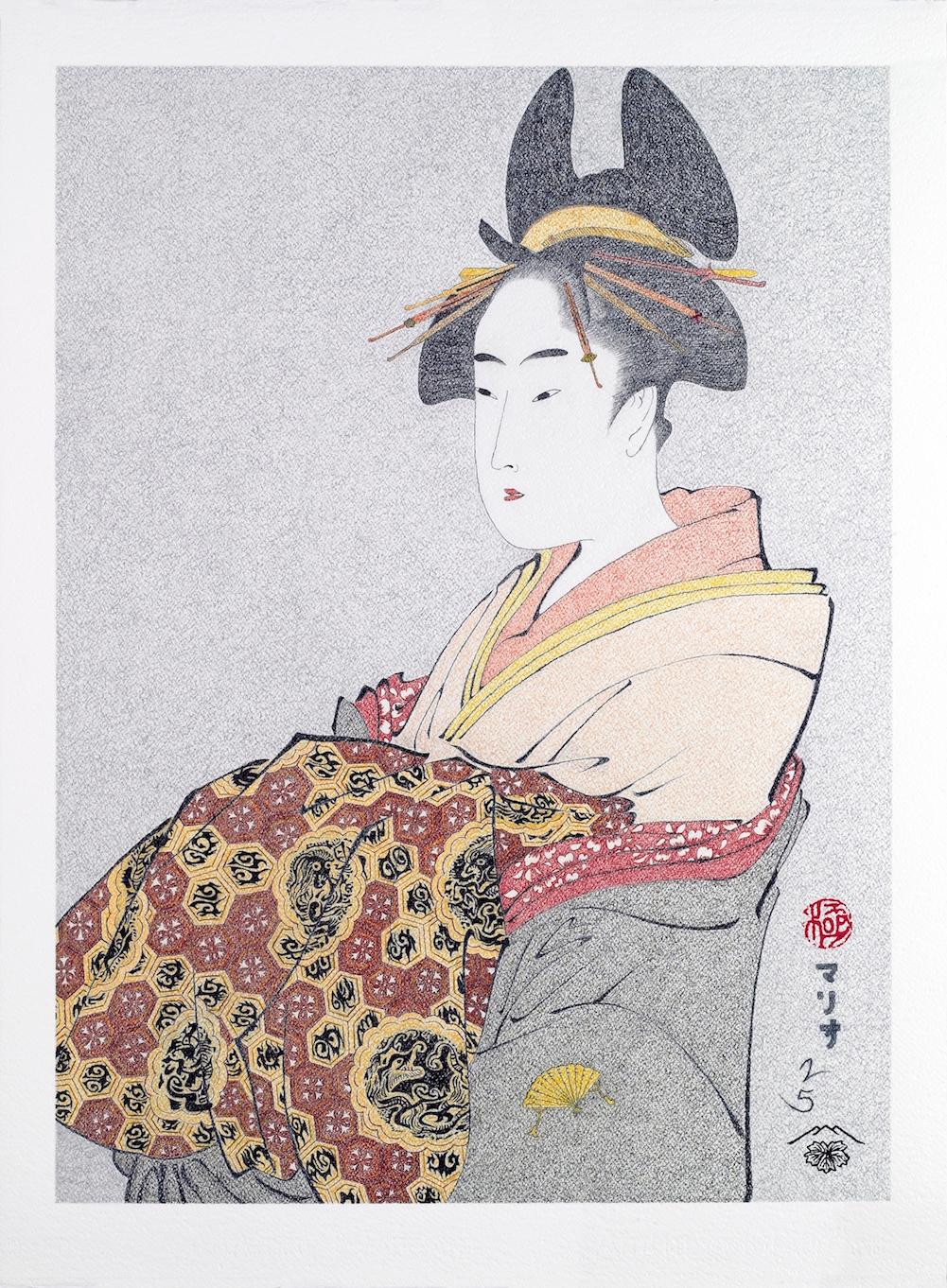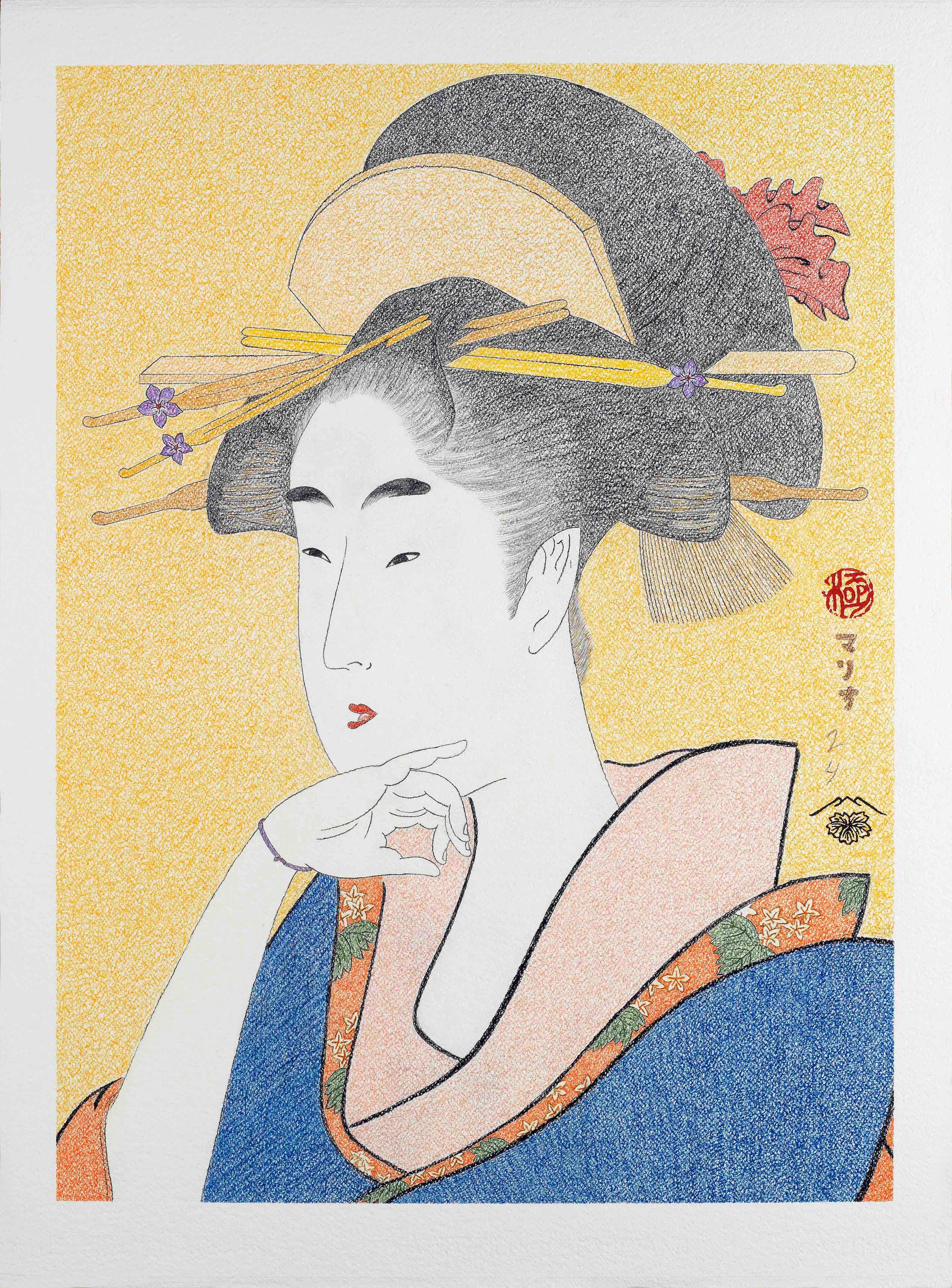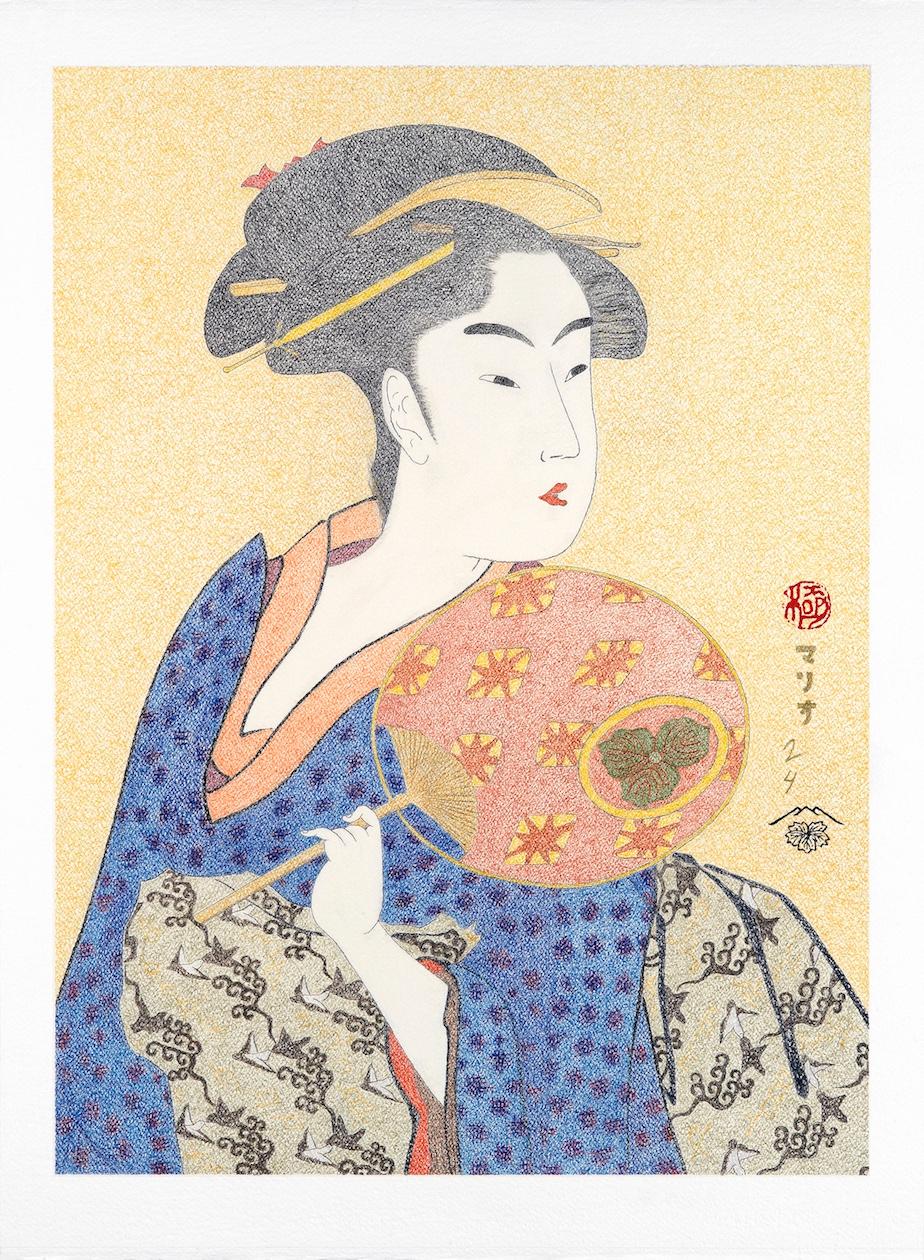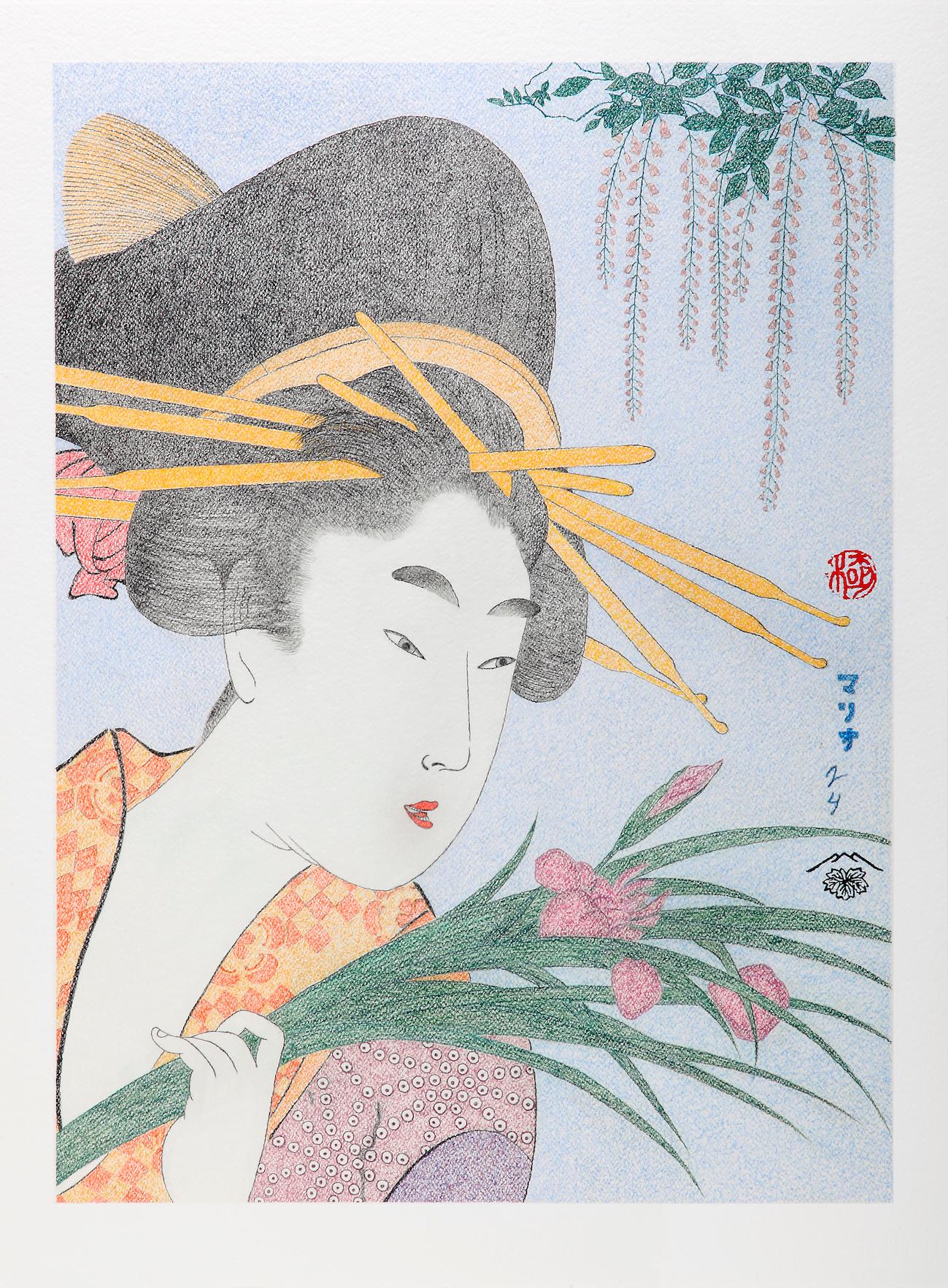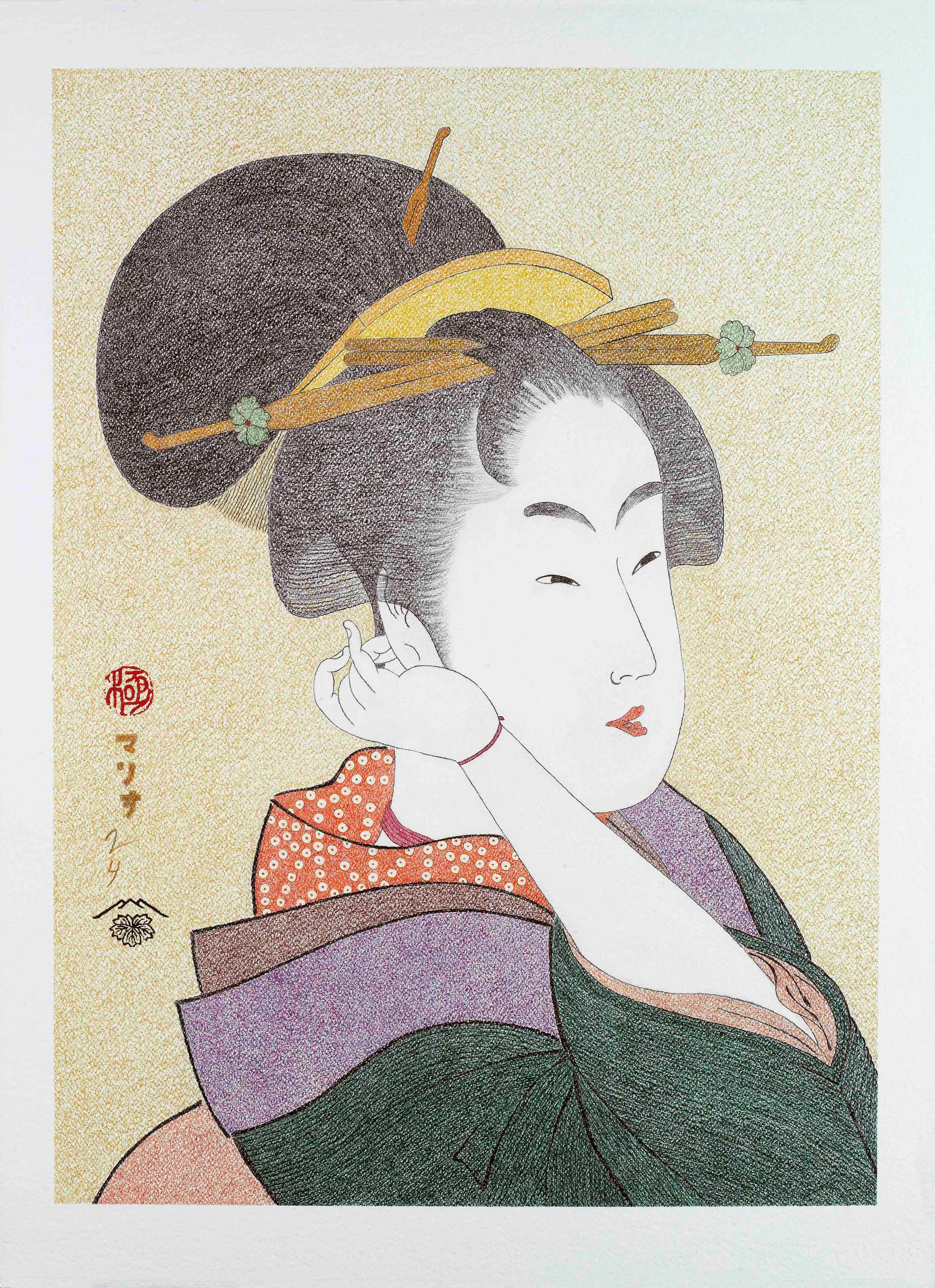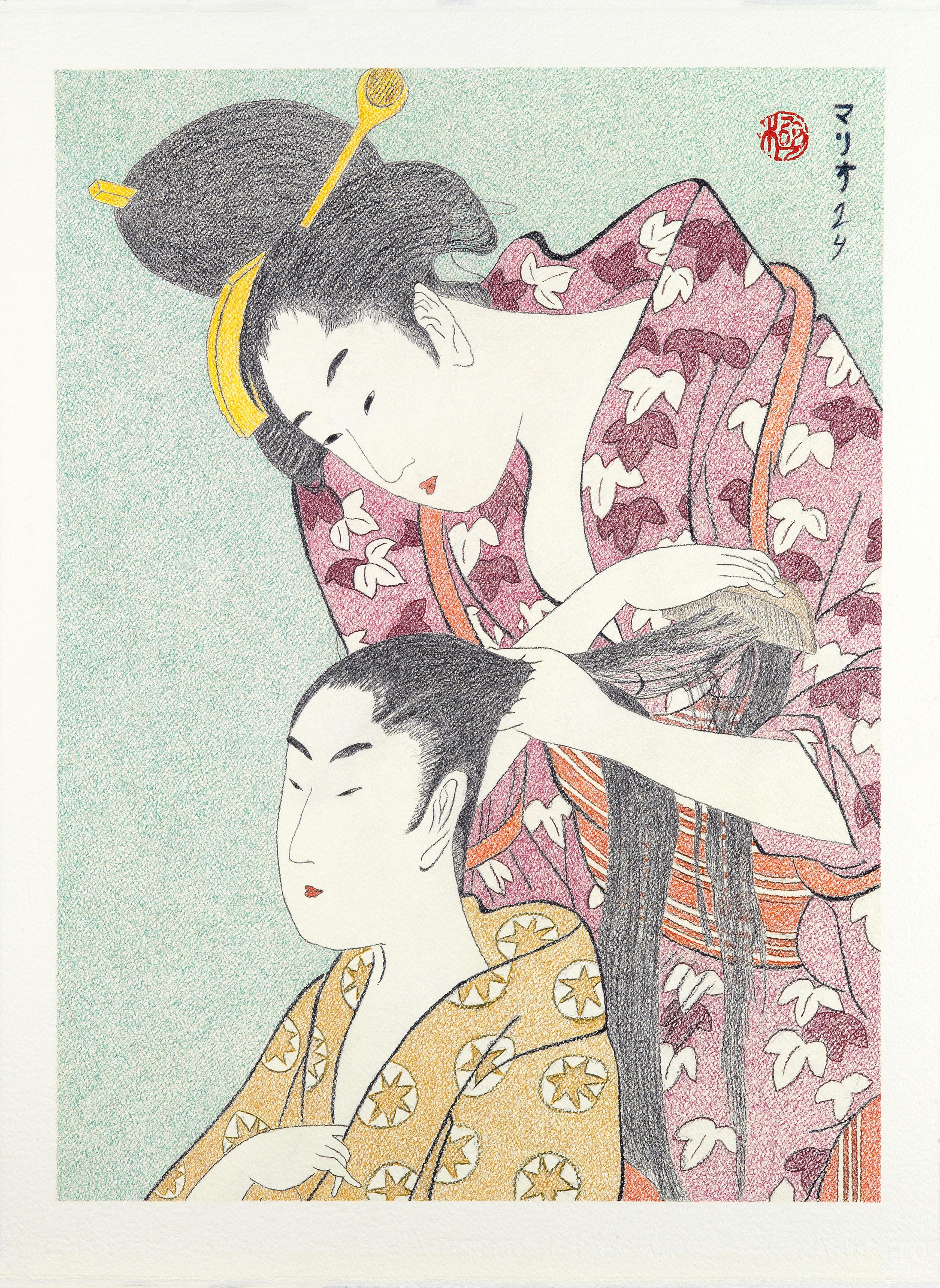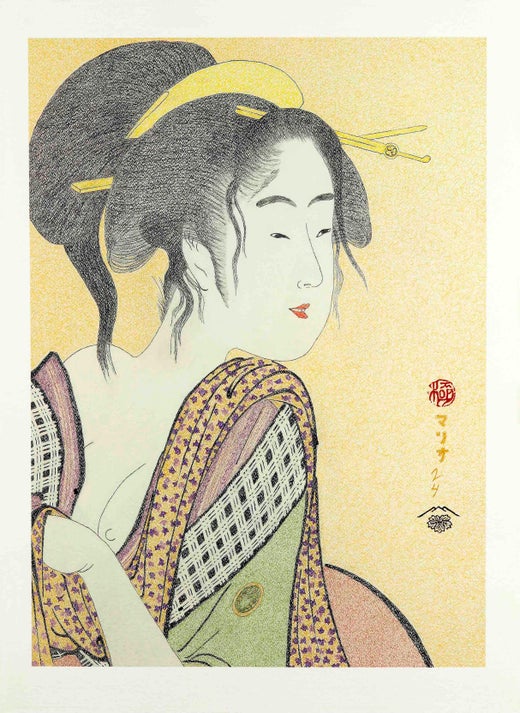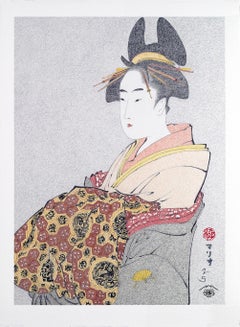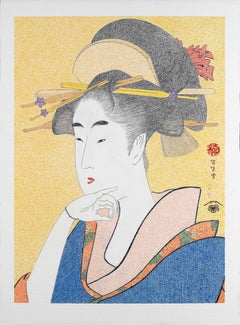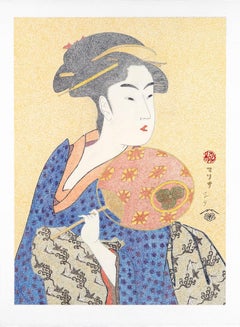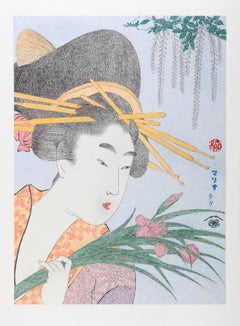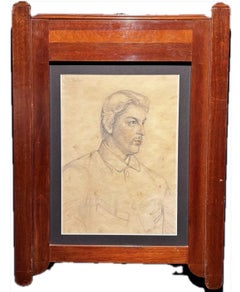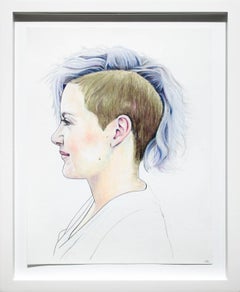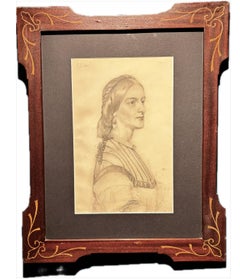Items Similar to Japanese Art Ukiyo-e Figurative Painting, Somenosuke of the Matsubaya Edo period
Want more images or videos?
Request additional images or videos from the seller
1 of 11
Mario B. GilJapanese Art Ukiyo-e Figurative Painting, Somenosuke of the Matsubaya Edo period2014
2014
About the Item
Bijin-ga series XXV (Nº 25)
Title: SOMENOSUKE OF THE MATSUBAYA
Somenosuke of house Matsubaya, known as a youthful courtesan who quickly rose through the ranks of popularity is shown producing a concealed letter, glancing about to confirm she is indeed alone.
The highlights of the drawing are the fine carving of the courtesan´s hair-line and the fine dress; an elegant kimono with vivid colors and intricate dessing.
This image is part of the bijin-ga series (“Pretty women”) drawn by Mario BGil, based in the Kitigawa Utamaro woodblock print Somenosuke of the Matsubaya (1794), 37,8 x 25,3 cm. Art Institute Chicago, USA.
The artist reproduces the seal of the censor (Kiwame) and from the original publisher (Tsuta, climbing leaf)), between the two, the signature of Mario BGil written in Japanese, with the date 14 (2014.
The mesaurements of the drawing are 76 x 56 cm. (29,92 x 22,05 in.), with a painted surface of 67 x 49,5 cm.
With his work on the bijing-ga series, Mario BGil wanted to embellish, give brilliance and volume to the images presented by japanese artist Kitigawa Utamaro in those beautiful engravings, ennobled with the patina of time, which have served as inspiration. The result obtained is almost life-size portraits, endowed with strong chromaticism and valuable contrasts, all enhanced, in turn, with the volume provided by the weight and rigidity of the paper, and its thick texture (Fabriano Artistico “grana grosso”, 640g/m2; the thickness and hardness of the paper makes it necessary to transport it without rolling).
In this way, Mario BGil pays tribute to his admired artist and offers us a new and enriched vision of this popular facet of oriental art from the 18th and 19th centuries.
ABOUT THE ARTIST
Mario BGil is a self-taught artist who for years has combined his creative activity with his work in the business world, away from commercial art galleries. Man of very diverse interests and great artistic sensitivity, studied Art History and in 2012, a deep interest in oriental art was awakened in him so that he began to study the great masters of Japanese Ukiyo-e prints, who had such an influence on the European avant-garde of the late 19th century.
The discovery of Kitagawa Utamaro (1753-1806), a key figure in the metropolitan culture of Edo (now Tokyo), and a point of reference in the history of Japanese engraving, meant for Mario a change of course caused by the imperative need to study his images, recreate them and recreate himself in them, incorporating certain changes in both the format and the technique used.
The technique used by MBG is very different from that used in engravings with wooden blocks impregnated in inks of intense colors that serve as a model. On a paper of heavy weight and thick texture, Mario BGil outlines with a black pencil, and colors the spaces with pencils and watercolors. Faced with the intensity of color of the prints (already very lost in some of them due to their age and exposure to the sun), their drawings are sifted by the streaky white, due to the thick texture of the paper, showing more lines, soft and warmer tones, giving color to the backgrounds but leaving all the volumes corresponding to the skin blank, thus giving the figures a classic serenity that transcends their oriental character.
Between 2014 and 2015, Mario BGil made more than 35 drawings based on the prints selected from the huge amount of work produced by the master Utamaro that shows images of courtesans in different attitudes and poses that highlight the subtle delicacy of oriental feminine beauty.
Kitagawa Utamaro was a faithful representative of the tastes of the Japanese bourgeoisie of its time, which had transformed the life of the cities giving birth to a culture parallel to the official and aristocratic.
The activity of the new rising group took place in special neighborhoods of Edo (Tokyo) and Osaka and its banality, inconsistency and frivolity earned it the name of Ukiyo: "floating world"; a world that will give priority to a series of cultural manifestations much more popular and less intellectualized than those preferred by the nobility. The new neighborhoods are filled with brothels and shows that the upper classes will consider vain, and a new breed of heroes: sumo wrestlers, singers, actors and courtesans will come to reign in this "floating world."
In front of the traditional painting the stamp arises with images of this new world. The courtesans of the pleasure districts of Edo that Utamaro portrays, do not always appear perfectly dressed to receive the client, but are surprised while getting ready, or during the day. He observes them without being seen, spy on them in their daily and intimate work. All of them are women drawn in a similar style, with elongated faces, straight delicate noses (almost a single line) and other features reduced to a mere suggestion (the mouth, a tiny butterfly of red).
The importance that it has had in later European artists (Degas, Toulouse-Lautrec, Bonnard, Gauguin, Van Gogh ...) has been great and Mario BGil has not been able to escape the recreation of those images so classic and, at the same time, so current, paying clear tribute to its original creator.
BIOGRAPHY Mario BGil is a self-taught artist who for years has combined his creative activity with his work in the business world, away from commercial art galleries. Man of very diverse interests and great artistic sensitivity, studied Art History and in 2012, a deep interest in oriental art was awakened in him so that he began to study the great masters of Japanese Ukiyo-e prints, who had such an influence on the European avant-garde of the late 19th century. The discovery of Kitagawa Utamaro (1753-1806), a key figure in the metropolitan culture of Edo (now Tokyo), and a point of reference in the history of Japanese engraving, meant for Mario a change of course caused by the imperative need to study his images, recreate them and recreate himself in them, incorporating certain changes in both the format and the technique used. The technique used by MBG is very different from that used in engravings with wooden blocks impregnated in inks of intense colors that serve as a model. On a paper of heavy weight and thick texture, Mario BGil outlines with a black pencil, and colors the spaces with pencils and watercolors. Faced with the intensity of color of the prints (already very lost in some of them due to their age and exposure to the sun), their drawings are sifted by the streaky white, due to the thick texture of the paper, showing more lines, soft and warmer tones, giving color to the backgrounds but leaving all the volumes corresponding to the skin blank, thus giving the figures a classic serenity that transcends their oriental character. Between 2014 and 2015, Mario BGil made more than 35 drawings based on the prints selected from the huge amount of work produced by the master Utamaro that shows images of courtesans in different attitudes and poses that highlight the subtle delicacy of oriental feminine beauty. Kitagawa Utamaro was a faithful representative of the tastes of the Japanese bourgeoisie of its time, which had transformed the life of the cities giving birth to a culture parallel to the official and aristocratic. In front of the traditional painting, the stamp arises with images of this new world. The courtesans of the pleasure districts of Edo that Utamaro portrays, do not always appear perfectly dressed to receive the client but are surprised while getting ready, or during the day. He observes them without being seen, and spies on them in their daily and intimate work. All of them are women drawn in a similar style, with elongated faces, straight delicate noses (almost a single line), and other features reduced to a mere suggestion (the mouth, a tiny butterfly of red). The importance that it has had in later European artists (Degas, Toulouse-Lautrec, Bonnard, Gauguin, Van Gogh ...) has been great and Mario BGil has not been able to escape the recreation of those images so classic and, at the same time, so current, paying clear tribute to its original creator.
About the Seller
5.0
Vetted Professional Seller
Every seller passes strict standards for authenticity and reliability
Established in 2002
1stDibs seller since 2017
66 sales on 1stDibs
Typical response time: <1 hour
- ShippingRetrieving quote...Shipping from: Bilbao, Spain
- Return Policy
Authenticity Guarantee
In the unlikely event there’s an issue with an item’s authenticity, contact us within 1 year for a full refund. DetailsMoney-Back Guarantee
If your item is not as described, is damaged in transit, or does not arrive, contact us within 7 days for a full refund. Details24-Hour Cancellation
You have a 24-hour grace period in which to reconsider your purchase, with no questions asked.Vetted Professional Sellers
Our world-class sellers must adhere to strict standards for service and quality, maintaining the integrity of our listings.Price-Match Guarantee
If you find that a seller listed the same item for a lower price elsewhere, we’ll match it.Trusted Global Delivery
Our best-in-class carrier network provides specialized shipping options worldwide, including custom delivery.More From This Seller
View AllJapanese Art Ukiyo-e Figurative Painting, Miyahito of The Ôgiya, Edo Period
Located in Segovia, ES
Bijin-ga Series XXXIV (Nº 34)
Title: Miyahito of the Ôgiya
Three quarter portrait of the elegant courtesan Miyahito of the Ôgiya House. This beautifully dressed japanese woman wears a solid grey outer robe, which contrasts with her soft rose kimono and the colored obi with an intricate geometric pattern. Her hair is arranged high atop her head, adorned with several hairpins. A classic Utamaro beauty print recreated with extraordinary taste and subtlety by Mario BGil in this delicate drawing.
This image is part of the bijin-ga series (“Pretty women”) drawn by Mario BGil, based in the Kitigawa Utamaro woodblock print...
Category
2010s Edo Figurative Drawings and Watercolors
Materials
Paper, Crayon, Oil Crayon, Graphite
$4,629 Sale Price
31% Off
Japanese Art Ukiyo-e Figurative Painting, Bijin Ôkubi, Edo Period
Located in Segovia, ES
Bijin-ga series XXIX (Nº 29)
Title: Bijin Ôkubi
Upper torso portrait of a Japanese beauty, depicted with a graceful hand gesture and an ornate headdress. Her soft round features contrast with the colourful sharp angles of the collars of her kimono.
Her elongated oval face, straight nose and red butterfly lips are typical of the prototype of a beautiful woman, Bijin-ga. Her upper torso and face occupying the central section of the picture show a composition type that became known in time as Large-head pictures, or Okubi-e; compositions with which Utamaro became a model for generations of woodblock artists.
This image is part of the Bijin-ga series (“Pretty women”) drawn by Mario BGil, based in the Kitigawa Utamaro woodblock print...
Category
2010s Edo Figurative Drawings and Watercolors
Materials
Paper, Crayon, Oil Crayon, Graphite
Japanese Art Ukiyo-e Figurative Painting, Takashimayaoisha, Edo period
Located in Segovia, ES
Beijing-ga Series XXX (nº 30)
Title: “Takashimaohisa”
Ohisa, along with Okita and Tomimoto Toyohina, were the three most famous beauties of the time. The first two were waitresses...
Category
2010s Edo Figurative Drawings and Watercolors
Materials
Crayon, Paper, Oil Crayon, Graphite
Japanese Art Ukiyo-e Figurative Painting, Hitomoto of the Daimonjiya, Edo period
Located in Segovia, ES
“Hitomoto of The Daimonjiya in Kyô-Machi Itchôme”
Hitomoto holds a bouquet of flowers looking to her left, with a surprised face, and with her mouth aj...
Category
2010s Edo Figurative Drawings and Watercolors
Materials
Paper, Crayon, Oil Crayon, Graphite
Japanese Art Ukiyo-e Figurative Painting, Tatsumi Roko, Edo Period
Located in Segovia, ES
Bijin-ga series XXVIII (Nº 28)
Title: Tatsumi Roko
Portrait of Tatsumi Roko, a geisha of the pleasure quarters in the Edo period. The image belongs to the series Renowed Beauties Likened to the Six Inmortal Poets.
The popular top-class geishas of the day , known as “oiran”, were depicted in this type of print. In ukiyo-e woodblock prints, this close-up portrait view of the upper body is known as an okubi-e (bust portrait).
This image is part of the bijin-ga series (“Pretty women”) drawn by Mario BGil, based in the Kitigawa Utamaro woodblock print...
Category
2010s Edo Figurative Drawings and Watercolors
Materials
Paper, Crayon, Oil Crayon, Graphite
Japanese Art Ukiyo-e Figurative Painting, Hairdresser, Edo period
Located in Segovia, ES
Bijin-ga series II (nº 02)
Title: “Hairdresser”
The interest in this picture is focused on the hairstyles of both women, a hairdresser leaning forward with a bow of intense black color, arranging his client's especially long hair. The ways of gripping both the hair and the comb, making it slide through the ocher-scented kimono of the customer, decorated with sea stars, stand out. Highlighting with great detail the drawing of loose hair on the obi of white lines on a red background, and the kosode of plum color.
This image is part of the Bijin-ga Series (“Pretty women”) drawn by Mario BGil, based in the Kitigawa Utamaro woodblock print "Hairdresser" (1798-1799), 39,8 x 26,8 cm. Museum of Fine Arts. Boston-USA.
Utamaro drawn a series of twelve prints whose themes were related to the manual works of women, and this "Hairdresser" is one of them.
Mario BGil reproduces the seal of the censor (Kiwame) and writes his own signature, Mario BGil, in Japanese, with the date 14 (2014).
The mesaurements of the drawing are 76 x 56 cm. (29,92 x 22,05 in.), with a painted surface of 67 x 49,5 cm.
With his work on the bijing-ga series, Mario BGil wanted to embellish, give brilliance and volume to the images presented by japanese artist Kitigawa Utamaro in those beautiful engravings, ennobled with the patina of time, which have served as inspiration. The result obtained is almost life-size portraits, endowed with strong chromaticism and valuable contrasts, all enhanced, in turn, with the volume provided by the weight and rigidity of the paper, and its thick texture (Fabriano Artistico “grana grosso”, 640g/m2; the thickness and hardness of the paper makes it necessary to transport it without rolling).
In this way, Mario BGil pays tribute to his admired artist and offers us a new and enriched vision of this popular facet of oriental art from the 18th and 19th centuries.
ABOUT THE ARTIST
Mario BGil is a self-taught artist who for years has combined his creative activity with his work in the business world, away from commercial art galleries. Man of very diverse interests and great artistic sensitivity, studied Art History and in 2012, a deep interest in oriental art was awakened in him so that he began to study the great masters of Japanese Ukiyo-e prints, who had such an influence on the European avant-garde of the late 19th century.
The discovery of Kitagawa Utamaro (1753-1806), a key figure in the metropolitan culture of Edo (now Tokyo), and a point of reference in the history of Japanese engraving...
Category
2010s Edo Figurative Drawings and Watercolors
Materials
Paper, Crayon, Oil Crayon, Graphite
You May Also Like
" Studio per ritratto di Philip Bedingfeld" 1870 ca cm. 25 x 36
Located in Torino, IT
Studio a matita e pastelli per lo splendido ritratto di Philip Bedingfeld proprietà del Museo del Norfolk
Frederick Sandys, (Norwich, 1º maggio1829 ...
Category
1870s Pre-Raphaelite Portrait Drawings and Watercolors
Materials
Crayon, Graphite, Paper
"Veneer" Figurative Drawing, Color Pencil, Ballpoint Pen, Graphite
By Lauren Rinaldi
Located in Philadelphia, PA
"Veneer" is an original oil pastel, ballpoint pen, color pencil, and graphite on arches paper work by Lauren Rinaldi. This piece ships in the pictured archival custom frame. The pape...
Category
21st Century and Contemporary Contemporary Figurative Drawings and Water...
Materials
Oil Pastel, Archival Paper, Ballpoint Pen, Color Pencil, Graphite
"Truer Than True" ballpoint pen, figurative portrait
By Lauren Rinaldi
Located in Philadelphia, PA
Original drawing by Lauren Rinaldi float mounted in the pictured simple white frame measuring 17in x 14in.
Lauren Rinaldi works using unbiased portraits of women’s bodies as a veh...
Category
21st Century and Contemporary Contemporary Portrait Drawings and Waterco...
Materials
Archival Paper, Ballpoint Pen, Graphite, Oil Pastel
" Studio per Ritratto di Lady Anne Simms Reeve of Brancaster Hall " 1870 ca
Located in Torino, IT
Raro studio dell'artista Preraffaellita Frederick Sandys,Studio per l’opera
Portrait of a Lady,( Anne Simms Reeve of Brancaster Hall, Norfolk) proprie...
Category
1870s Pre-Raphaelite Portrait Drawings and Watercolors
Materials
Crayon, Graphite
$9,045 Sale Price
35% Off
Free Shipping
Study of a woman in repose - Russian School
Located in Middletown, NY
Pencil on cream wove paper, 9 1/4 x 7 7/8 inches (235 x 200 mm). Overall toning with multiple spots of white discoloration throughout, and a spray of foxing across the image area on ...
Category
Early 20th Century Naturalistic Portrait Drawings and Watercolors
Materials
Paper, Pencil, Graphite
"Dragonfly Mother" (2023) By Babs Webb and Timothy Von Rueden
Located in Denver, CO
"Dragonfly Mother" is a beautiful collaboration between fantasy masters Babs Webb and Timothy Von Rueden, done with graphite on mixed media paper, and measuring at 14 x 11 in. in its...
Category
2010s Surrealist Portrait Drawings and Watercolors
Materials
Acrylic, Archival Paper, Graphite
Recently Viewed
View AllMore Ways To Browse
Edo Period Art
Edo Period Japanese Art
Japanese Course
Japan Engraving
House Of Brilliance
Ukiyo E
Japanese Ukiyo E
Master E S
Edo Period Japanese Painting
Edo Japanese Woodblock
Artist E Rose
Business And Pleasure
18th Century Paintings Of Women
Edo Period Woodblock
Series Of Black And White Face Drawings
Japanese Kimono Painted
Japanese Woodblock Beauties
Wrestlers Oil Painting
